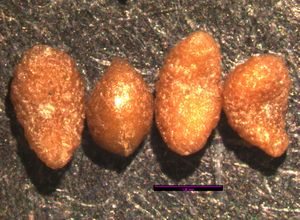Gilia capitata
- Latin Name: Gilia capitata
- Family: Polemoniaceae
- Common Names: bluehead gilia, globe gilia
- Codon: GILCAP
Contents
Taxonomy
Description
Bloom Period
May, June, July
Distribution
More common west of the Cascade summits,Vancouver Island, British Columbia, to California, east to Idaho
Habitat
Fairly common in dry to moist open meadows, rock outcrops, rocky slopes, clearings, and roadsides, at low to middle elevation; escaped from cultivation and established in a few places in southeast Alaska
Uses
Unknown human uses
Propagation
Seeds may be sown from autumn to early spring, but germination is better when planted with autumn rains. Self-sows readily
Seed
Seed sample from: 2011
Average Measurement: 1.7 x 1.1 x 0.7
Measurement Range: L: 1.2 – 2, W: 0.75 – 1.4, D: 0.5 – 1.1
Features
Shape: Seed narrow at hilium end, broadening at opposite apex. Hilium inconspicuous. Uniformity in shape is not that common, but most seeds take a relatively teardrop shaped.
Color: Seed is brown, very bumpy, and slightly lustrous.
Surface: Seed coat becomes very mucilaginous and stringy when wet.
Could be confused with COGRX, but GICA is about ½ the size and does not have sulcus.
Latitudinal Cross Section: elliptical ![]()
Longitudinal Cross Section: obovate ![]()
References
Basic Explanations and Assumptions:
The dimensions for the seeds are length x width x depth. The location of the hilum is used as the base of the seed, and the length is measured from hilum to the opposite apex. Where a style is present, the length is measured from the hilum to the bottom of the style. Width is measured at a right angle to the length at the widest part. Depth is measured at a right angle to the intersection of height and width lines.
Measurements included are the mean average for each measurement of ten separate seeds.
All measurements in millimeters unless otherwise noted.

